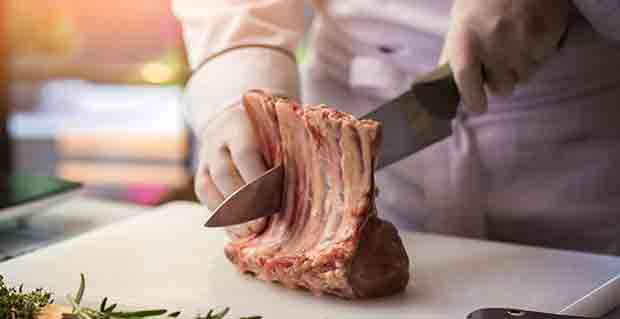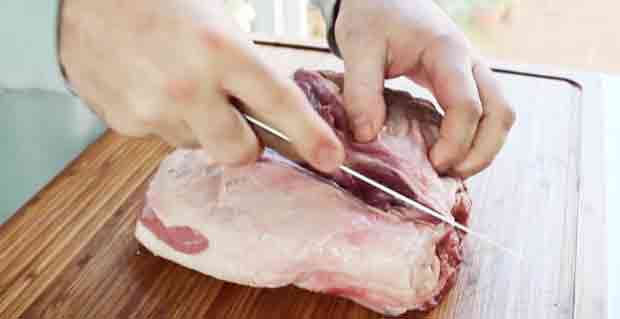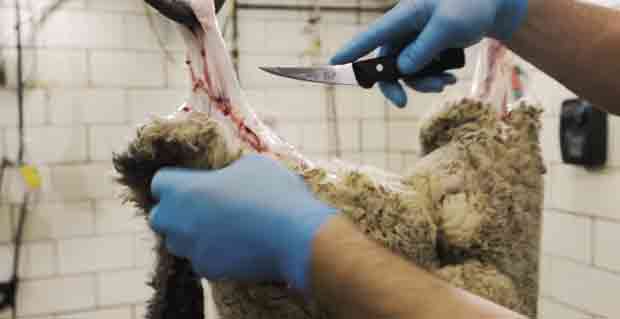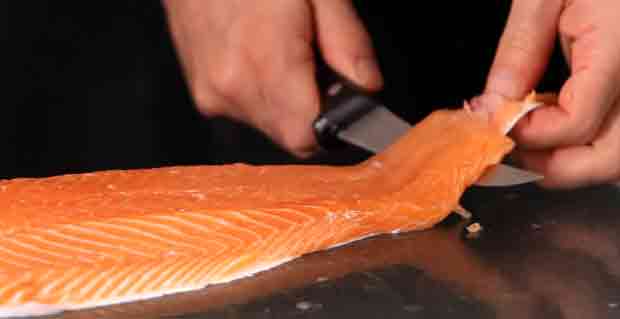A boning knife is thinner and smaller than the standard chef’s knife you’ll see in most kitchens, but what it lacks in size and thickness, it makes up for in versatility.
So, what is a boning knife used for?
The standard boning knife can do more than just slice meat and chop up vegetables.

Because of its thinner blade, it can slip into the crevices of certain cuts of meat. Thanks to its flexibility, it can then move around to execute more precise cuts that separate meat from bone. With its durable blade, it can still be used to power through tougher pieces of meat.
The boning knife is a great tool to have on hand in the kitchen and listed below are just some of the things you can do with it.
What is a Boning Knife Used For?
Application 1: for Removing Meat From the Bones

The Steps:
- Put the meat you want to debone on your board. Pick out a larger chopping board for this and then put the cut of meat right in the middle of it.
- Find the bones in the cut of meat you are working with either by trimming away some of the excess meat or just using your knife to feel for them.
- Insert the tip of your boning knife into that spot between the meat and the bone and then begin slicing. Slice in a way that you will expose the bone and create a larger entry point for your knife. Be mindful of where your fingers are located while making this initial cut.
- Use the tip of the knife to reach beneath the exposed bone at an angle. Begin slicing. Continue moving the boning knife back and forth until you have exposed as much of the bone as possible.
- With your non-cutting hand, hold on to a big enough portion of the exposed bone to keep it in place. Use your knife to scrape the meat away from the bone by executing some flicking motions. Raise your hand up the handle of the knife so that you have more control.
- After scraping away the meat from the exposed bone, focus on the other segments of the cut of meat you are working with. Dislodge the bone from the strands of meat that are still connected to it by executing smaller cuts and slices. You may find some cartilage while cutting away the meat. These will be tougher to cut through, so be firmer with the knife.
Application 2: for Removing Skin From the Meat

The Steps:
- Grab a large cutting board, and then place the cut of meat you want to work on in the middle of it, with the skin side facing up. The skin side is the one that features a slightly silver color, and it may also be covered by a layer of fat. If there is a layer of fat present on the cut of meat, you should be able to pull it away easily using your hand.
- Look for the spot in the cut where the silver skin is in direct contact with the meat. Once you’ve found that spot, take your boning knife and then cut into it. Don’t make the initial cut a deep one. A slit that goes about an inch deep is good enough. Grab hold of the silver skin as well and see if you can pry it loose from the meat using only your hands.
- If you are unable to dislodge the silver skin using only your hands, that’s not an issue. You just have to pick your knife up again and continue making cuts similar to the first one you did. While cutting the skin away from the meat, make sure to hold it tight with your other hand and gradually pull it away as well.
- After making some progress with the smaller cuts, you can now proceed to removing larger chunks of the skin from the meat. To do this, angle the blade of the boning knife upward and execute some longer cuts. Don’t forget to hold the skin you’re removing in your other hand.
- It’s time to completely remove the remaining silver skin from the meat, and to do that, you will have to finish the cuts you were making earlier. Completely detach the strips of silver skin from the meat. Repeat this process until the cut of meat no longer has any bit of silver skin on it.
Application 3: for Removing the Skin From a Fillet of Fish

The Steps:
- Place the fillet of fish on top of the cutting board with the skin side facing down. You should also have the narrower part of the fillet closer to you.
- Hold the tip of the fillet nearest to you and position your knife in between the meat and the skin. Using only the tip of your boning knife, create a two-inch incision that separates the meat of the skin. Be careful not to actually cut into the skin.
- Now that you have an entry point, position your knife between the meat and the skin again. With the fish lying on top of the board, hold your knife parallel to the board and begin slicing along the skin. Pull the skin away as you glide along the fillet.
- Before you completely go through the fillet, you should check on how you’re doing first. You can do this by lifting up the fillet and checking to see how much meat is left on the skin. If there’s no meat left behind or only a minimal amount, then just continue what you’re doing. If you are leaving too much on the skin, adjust the angle of the knife and begin from the entry point once more.
- After making sure that you are not leaving too much meat behind, you can go ahead and completely detach the skin from the fish. Again, just let the blade do all the work and follow its path along the fillet.
How to Choose a Boning Knife?
The Steps:
- All boning knives possess a decent amount of flexibility, but depending on what you are planning to do with one, you can look for added flexibility or a stiffer blade. If you are going to use the boning knife primarily for deboning bigger cuts of meat, then you should prioritize the stiffness. Flexibility is what you should look for if you are going to be skinning a lot of cuts with your knife.
- A boning knife that is about five to 6.5 inches long should work fine for a wide variety of applications. However, you may want to get a boning knife that is a bit longer if you are planning to work with larger cuts of meat in the future.
- Boning knives that are made out of high-carbon steel should be the ones you are looking for when you are out shopping. Blades made out of high-carbon steel are incredibly sharp, and they are great for deboning and skinning. These high-carbon blades are also very durable and they should remain useful to you for an extended period of time.
The boning knife is not going to be the largest one in your drawer, but it has a case to be called as the most versatile one in your collection.
You can do so many things with boning knives, ranging from creating neater cuts of meat to making chops and fillets that are quicker to cook because they no longer have bones in them.
If you’ve only used the boning knife for slicing before, now you know how to get the most out of it.



